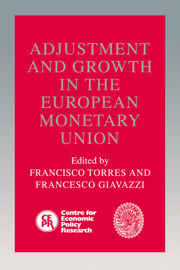Book contents
- Frontmatter
- Contents
- List of figures
- List of tables
- Preface
- List of contributors
- Foreword
- 1 Introduction
- 2 Economic and monetary union: critical notes on the Maastricht Treaty revisions
- Discussion
- 3 The design of optimal fiscal rules for Europe after 1992
- Discussion
- 4 Contracts, credibility and common knowledge: their influence on inflation convergence
- Discussion
- 5 Inflation in fixed exchange regimes: the recent Portuguese experience
- Discussion
- 6 Models of economic integration and localized growth
- Discussion
- 7 Shocking aspects of European monetary integration
- Discussion
- 8 Lessons of Massachusetts for EMU
- Discussion
- 9 Financial and currency integration in the European monetary system: the statistical record
- Discussion
- 10 Currency substitution: from the policy questions to the theory and back
- Discussion
- 11 Coordination of capital income taxes in the economic and monetary union: what needs to be done?
- Discussion
- Index
8 - Lessons of Massachusetts for EMU
Published online by Cambridge University Press: 29 January 2010
- Frontmatter
- Contents
- List of figures
- List of tables
- Preface
- List of contributors
- Foreword
- 1 Introduction
- 2 Economic and monetary union: critical notes on the Maastricht Treaty revisions
- Discussion
- 3 The design of optimal fiscal rules for Europe after 1992
- Discussion
- 4 Contracts, credibility and common knowledge: their influence on inflation convergence
- Discussion
- 5 Inflation in fixed exchange regimes: the recent Portuguese experience
- Discussion
- 6 Models of economic integration and localized growth
- Discussion
- 7 Shocking aspects of European monetary integration
- Discussion
- 8 Lessons of Massachusetts for EMU
- Discussion
- 9 Financial and currency integration in the European monetary system: the statistical record
- Discussion
- 10 Currency substitution: from the policy questions to the theory and back
- Discussion
- 11 Coordination of capital income taxes in the economic and monetary union: what needs to be done?
- Discussion
- Index
Summary
Introduction
Over the past decade the European Community has made great strides towards becoming a fully unified economic entity. Border obstacles and regulatory barriers to an integrated market for goods and services have been removed in the drive towards 1992; now, as the economic and monetary union (EMU) moves forward, an integrated capital market and eventually a common currency seem all but assured. By the end of the twentieth century Europe should, in many respects, constitute as unified and integrated an economy as the United States of America.
Most economists (myself included) view this as a generally good thing. Yet at any given time not everyone in the USA is entirely happy to be part of such a unified, integrated economy. In particular, over the past decade several regional economies within the United States have been subject to large adverse shocks — shocks which have arguably been so large precisely because the US economy is so integrated — for which they have had essentially no policy recourse simply because the US already has the common currency that EMU is supposed to produce for Europe.
The most intellectually influential of the regional crises in the US has been the recent slump in New England — the events are dramatic enough to be worth noting in any case, but proximity to certain univerisities has not hurt their academic visibility! The New England story is by now familiar in the US, but may be worth reviewing for Europeans.
- Type
- Chapter
- Information
- Adjustment and Growth in the European Monetary Union , pp. 241 - 266Publisher: Cambridge University PressPrint publication year: 1993
- 309
- Cited by



